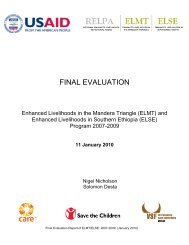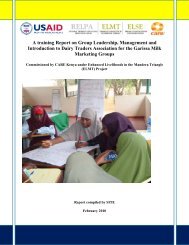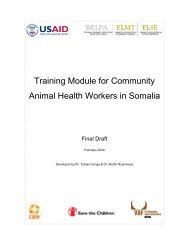Promoting Camel Husbandry in the Horn of Africa
Promoting Camel Husbandry in the Horn of Africa
Promoting Camel Husbandry in the Horn of Africa
You also want an ePaper? Increase the reach of your titles
YUMPU automatically turns print PDFs into web optimized ePapers that Google loves.
<strong>Promot<strong>in</strong>g</strong> <strong>Camel</strong> <strong>Husbandry</strong> <strong>in</strong><br />
<strong>the</strong> <strong>Horn</strong> <strong>of</strong> <strong>Africa</strong><br />
ELMT/ELSE Lessons Bazaar<br />
Hilton Hotel 14 th April 2010<br />
Addis Ababa<br />
presented by Dr Ilona Gluecks, VSF Suisse
Why?<br />
The camel is <strong>in</strong> <strong>the</strong> arid and semi arid<br />
areas <strong>the</strong> most important livestock<br />
species for <strong>the</strong> livelihoods <strong>of</strong><br />
pastoralists
The use <strong>of</strong> <strong>the</strong> dromedary camel<br />
• Milk<br />
– Household consumption<br />
• In dry season contribut<strong>in</strong>g<br />
to 50% <strong>of</strong> nutrient <strong>in</strong>take<br />
for pastoralist<br />
• Raw/resh milk<br />
• Fermented (“Susa”)<br />
– Bus<strong>in</strong>ess
The use <strong>of</strong> <strong>the</strong> dromedary camel<br />
• Transport and Work<br />
– Transport or pack animal<br />
• Household<br />
• Water<br />
• Goods (Milk)<br />
• Desert ambulance<br />
• <strong>Camel</strong> library (Garissa)<br />
• People (tourism)<br />
• Vacc<strong>in</strong>ation campaigns, solar powered<br />
camel fridges<br />
– Work<br />
• Plough<strong>in</strong>g
The use <strong>of</strong> <strong>the</strong> dromedary camel<br />
• Meat/live animals<br />
– Household<br />
consumption<br />
– Local Bus<strong>in</strong>ess<br />
• Sale males<br />
• Unproductive<br />
females for slaughter<br />
- Export Bus<strong>in</strong>ess<br />
Ma<strong>in</strong>ly to Arabian<br />
Pen<strong>in</strong>sula from<br />
Somalia
Why? – cont’d<br />
• Curriculum <strong>of</strong> vet universities do not <strong>in</strong>clude <strong>the</strong><br />
camel (recently achieved <strong>in</strong> Kenya, and <strong>in</strong><br />
Somalia Sheikh Veter<strong>in</strong>ary School)<br />
• International: Enormous research go<strong>in</strong>g on <strong>in</strong><br />
<strong>the</strong> Arab States (breed<strong>in</strong>g, reproduction,<br />
feed<strong>in</strong>g, disease related to rac<strong>in</strong>g camels) BUT<br />
very little or no research on <strong>the</strong> camel as a<br />
livestock species <strong>in</strong> pastoral areas<br />
• National: camel as species sidel<strong>in</strong>ed, focus on<br />
dairy cows ma<strong>in</strong>ly
Why? Cont’d<br />
• Importance <strong>in</strong> future might raise<br />
due to climatic changes<br />
(<strong>in</strong>creas<strong>in</strong>g number <strong>of</strong><br />
droughts…);<br />
The camel is very well adapted to<br />
hot, dry environments due to its<br />
physiology
<strong>Camel</strong>s <strong>in</strong> <strong>the</strong> world<br />
• 18.9 M camels <strong>in</strong> <strong>the</strong> world<br />
– 95% dromedary camels (<strong>Africa</strong>, Middle East)<br />
– 5% bactrian camels (Central Asia, Ch<strong>in</strong>a, Mongolia)<br />
• 82% (15.4 M) found on <strong>the</strong> <strong>Africa</strong>n Cont<strong>in</strong>ent<br />
– Somalia 6.2 - 7 M<br />
– Sudan 3.2 - 3.5 M<br />
– Ethiopia 1.4 - 2.3 M<br />
– Mauritania 1.3 M<br />
– Kenya 0.8 to 1 M
<strong>Camel</strong>s <strong>in</strong> <strong>Africa</strong>
Idea/Aim<br />
• Improve/streng<strong>the</strong>n camel health and<br />
husbandry<br />
• Promote camel production, products<br />
• Build capacity<br />
• Promote and advocate for <strong>the</strong> camel as<br />
important livestock species nationally,<br />
<strong>in</strong>ternationally (fora, conferences)<br />
• Promote and engage <strong>in</strong>to research (l<strong>in</strong>k<strong>in</strong>g<br />
research and development)
Projects<br />
• Farm <strong>Africa</strong>’s Pastoralist Development Project 1988 for 12 years <br />
focus on camel health and husbandry (Best practice series)<br />
– Provision <strong>of</strong> vet services to camel owners<br />
– Us<strong>in</strong>g demonstration herds for research, extension and tra<strong>in</strong><strong>in</strong>g<br />
– <strong>Camel</strong> improvement groups<br />
– Improv<strong>in</strong>g breeds through local stud bulls<br />
– Promotion <strong>of</strong> camel up take and <strong>of</strong>f take<br />
• <strong>Camel</strong> market<strong>in</strong>g<br />
• <strong>Camel</strong> for slaughter<br />
– Promotion <strong>of</strong> production <strong>of</strong> value added<br />
– products<br />
• Condensed milk<br />
• Meat products<br />
– Promotion <strong>of</strong> diversification<br />
• Traction, plough<strong>in</strong>g, transport, leisure<br />
– School camel program
Outcome<br />
– Formation <strong>of</strong> <strong>the</strong> Kenya <strong>Camel</strong> Association<br />
• Members ma<strong>in</strong>ly pastoralists and o<strong>the</strong>r <strong>in</strong>terested<br />
groups and people (scientists, ranchers, NGOs)<br />
• Annual Kenya <strong>Camel</strong> Forum conducted <strong>in</strong> various<br />
districts <strong>of</strong> <strong>the</strong> ASAL <strong>of</strong> Kenya<br />
• Exchange cross border Somali and Ethiopian<br />
Pastoralists
Improve camel health and husbandry<br />
• Tra<strong>in</strong><strong>in</strong>g <strong>of</strong> vet pr<strong>of</strong>essionals on<br />
camel health aspects<br />
• Development <strong>of</strong> a “Manual for<br />
<strong>Camel</strong> Service Providers (CASPRO)”<br />
• Tra<strong>in</strong><strong>in</strong>g <strong>of</strong> CASPROs<br />
• Ensur<strong>in</strong>g availability <strong>of</strong> camel<br />
specific drugs <strong>in</strong> <strong>the</strong> arid areas<br />
• Access to and discussion <strong>of</strong> <strong>the</strong><br />
traditional knowledge <strong>of</strong> camel keep<strong>in</strong>g<br />
communities (diseases, husbandry practices)<br />
• Support<strong>in</strong>g pastoralists to attend <strong>the</strong> Kenya<br />
<strong>Camel</strong> Forum held annually
Promote camel production, products<br />
• Advocat<strong>in</strong>g on acceptance <strong>of</strong> camel milk by<br />
Kenya Dairy Board<br />
Standards for camel milk developed (KEBS)<br />
• Improv<strong>in</strong>g milk hygiene, handl<strong>in</strong>g and quality<br />
along <strong>the</strong> milk market value cha<strong>in</strong> through<br />
tra<strong>in</strong><strong>in</strong>g <strong>of</strong> pastoralist producers, middlemen,<br />
traders and consumers<br />
• Introduction <strong>of</strong> more hygienic<br />
transport conta<strong>in</strong>ers<br />
• Development <strong>of</strong> milk bars<br />
• Advocat<strong>in</strong>g for market<br />
<strong>in</strong>frastructure and systems with<br />
county council/local authorities
Promote camel production, products cont’d<br />
• Tra<strong>in</strong><strong>in</strong>g on milk process<strong>in</strong>g (yoghurt,<br />
condensed milk, t<strong>of</strong>fees)<br />
• Tra<strong>in</strong><strong>in</strong>g <strong>of</strong> groups on<br />
meat process<strong>in</strong>g “njirnjiri”
Promote camel production, products cont’d<br />
• Re-stock<strong>in</strong>g <strong>of</strong><br />
– <strong>Camel</strong>s as pack animals toge<strong>the</strong>r with small<br />
rum<strong>in</strong>ants<br />
– <strong>Camel</strong>s as source <strong>of</strong> milk<br />
– <strong>Camel</strong>s as new species (Samburu, Borana,<br />
Maasai)
Promote and engage <strong>in</strong>to research<br />
• Investigation <strong>of</strong> <strong>Camel</strong> Sudden Death<br />
Syndrome (CSD) – Survey and<br />
Diagnostics<br />
– Kenya, Somalia, Ethiopia<br />
• Def<strong>in</strong><strong>in</strong>g <strong>the</strong> prevalence <strong>of</strong> Brucellosis <strong>in</strong><br />
camel milk<br />
– Kenya
Promote and engage <strong>in</strong>to research cont’d<br />
Participatory Study on <strong>the</strong> Epidemiology<br />
<strong>of</strong> Haemorrhagic Septicaemia <strong>in</strong> <strong>Camel</strong>s<br />
(<strong>Camel</strong>us Dromedarius) <strong>in</strong> Nor<strong>the</strong>rn<br />
Kenya complemented by Bacteriological<br />
Analysis and Molecular Identification<br />
and Differentiation<br />
Kenya, partly Somalia
<strong>Promot<strong>in</strong>g</strong> <strong>the</strong> camel<br />
• Tra<strong>in</strong><strong>in</strong>g <strong>of</strong> veter<strong>in</strong>arians under <strong>the</strong> ELMT/ELSE<br />
project on camel health and husbandry practices<br />
–1 st Tra<strong>in</strong><strong>in</strong>g workshop <strong>in</strong> Moyale, Ethiopia<br />
–2 nd Tra<strong>in</strong><strong>in</strong>g workshop <strong>in</strong> Dire Dawa, Ethiopia<br />
• Formation <strong>of</strong> <strong>the</strong> <strong>Camel</strong> Forum Ethiopia <strong>in</strong><br />
October 2009<br />
– Under <strong>the</strong> M<strong>in</strong>istry <strong>of</strong> Agriculture and Rural<br />
Development, Animal and Plant Health Regulatory<br />
Directorate<br />
– Bi-laws and strategy developed<br />
– Newsletter
Promote and advocate for <strong>the</strong> camel as important<br />
livestock species nationally, <strong>in</strong>ternationally<br />
• Attend<strong>in</strong>g <strong>in</strong>ternational conferences (ISOCARD, Al A<strong>in</strong><br />
2006, Djerba 2009)<br />
• World Buiatric Conference (Budapest 2008)<br />
• Regional Livestock Forum (FAO)<br />
• Donors (USAID, EC, ECHO, <strong>the</strong> Wellcome Trust)<br />
• Kenya <strong>Camel</strong> Forum / <strong>Camel</strong> Forum Ethiopia<br />
• Kenya Dairy Board, Kenya Bureau <strong>of</strong> Standards<br />
• L<strong>in</strong>e M<strong>in</strong>istries<br />
• National and <strong>in</strong>ternational research Institutes (KARI,<br />
ILRI)<br />
• iNGOs<br />
• Kenya Pastoralist Week<br />
• HoA Pastoralist Network<br />
• OiE
Upcom<strong>in</strong>g possibilities<br />
“The International <strong>Camel</strong> Symposium –<br />
L<strong>in</strong>k<strong>in</strong>g <strong>Camel</strong> Science and Development<br />
for Susta<strong>in</strong>able Livelihoods”<br />
7 th to 10 th June 2010, Garissa, Kenya<br />
http://www.kari.org/<strong>the</strong>kenyacamelsymposium2010.htm<br />
kenyacamelsymposium@gmail.com
THANKS












